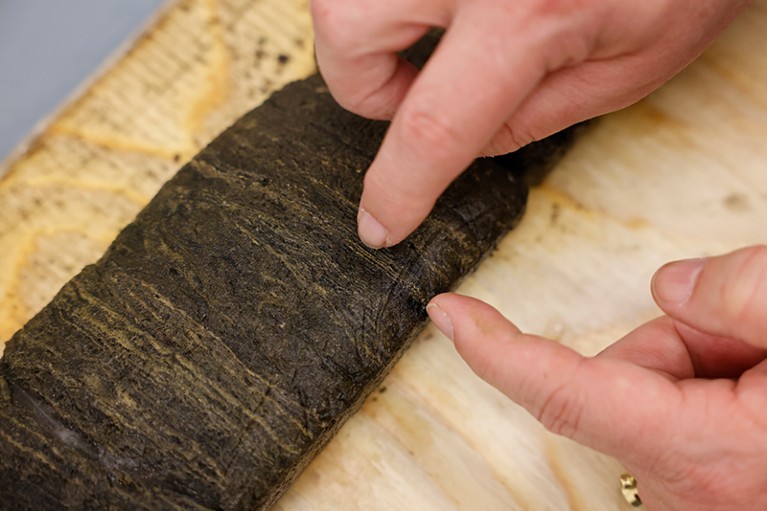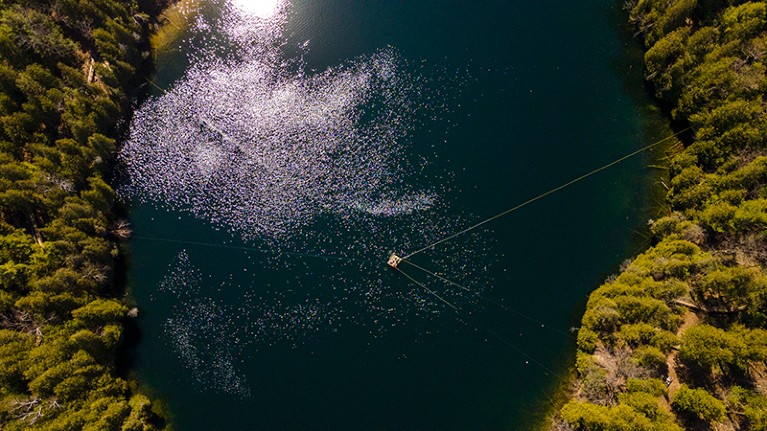The official marker for the start of a new Anthropocene epoch should be a small Canadian lake whose sediments capture chemical traces of the fallout from nuclear bombs and other forms of environmental degradation. That’s a proposal out today from researchers who have spent 14 years debating when and how humanity began altering the planet.
If the proposal is approved, a sediment core from Crawford Lake — which lies in a conservation area near Toronto — would become the ‘golden spike’ marking the beginning of the Anthropocene, the geological epoch in which humanity has profoundly affected Earth. Year after year, particles settle onto the lake and drift to its bottom, forming sediment layers that record environmental conditions much as tree rings do. Among the embedded contaminants are specks of fly ash— remnants from burning fossil fuels — and traces of radioactive plutonium from atmospheric nuclear bomb testing.
“We have the key markers of the Anthropocene — at Crawford Lake they line up perfectly,” says Francine McCarthy, a micropalaeontologist at Brock University in St Catharines, Canada, who heads the team that studies1 the lake.
The Anthropocene Working Group announced the lake’s nomination at a stratigraphy conference in Lille, France, and a press conference in Berlin. Three geological organizations must approve the choice for it to become the official marker.
Contentious golden spike
Not all Earth scientists are enthused by the idea of an Anthropocene golden spike, saying that pegging the start of the epoch to a recent time and place misses the point that humans have been changing the planet for much longer. “European scientists seem to be quite captivated that this time period starts very recently,” says Zoe Todd, an anthropologist with Red River Métis ancestry at Simon Fraser University in Burnaby, Canada, who has published on2 the Anthropocene. “For Indigenous and other displaced and dispossessed peoples who were impacted by massive forms of violence that characterize the last 600 years, everything that leads up to what makes this global shift possible starts much earlier.”
The work to define an age of human impacts has taken “a tremendous amount of effort, to solve a problem that I don’t think exists”, adds Jacquelyn Gill, a palaeoecologist at the University of Maine in Orono. “We all already know what we mean when we say the Anthropocene.”
But supporters say that formalizing a new epoch has potent symbolic value. The Anthropocene golden spike is not meant to acknowledge the start of human activity on Earth but the planet’s response to overwhelming change, says Colin Waters, a geologist at the University of Leicester, UK, who chairs the working group.
Human fingerprints
An Anthropocene marker would join similar sites designating other geological time boundaries. A spot in the Greenland ice sheet, for example, designates the beginning of the current Holocene epoch, 11,700 years ago. In 2019, the Anthropocene Working Group began discussing a shortlist of sites for a new epoch, ranging from a peat bog in Poland to a coral reef in Mexico. All of the proposed locations bear the fingerprints of human activity. Earlier this year, the group narrowed the list down to two finalists: Crawford Lake and Sihailongwan Lake in northeastern China. In April, Crawford Lake gained approval from 60% of the working group to earn the title of candidate golden-spike site.
Both lakes contain annual sediment layers that capture environmental changes over time. But unlike Crawford, which reflects the influence of nearby Toronto, Sihailongwan is relatively undisturbed by local influences and thus contains a broader record of change, says Yongmin Han, a geochemist at the Institute of Earth Environment of the Chinese Academy of Sciences in X’ian. “I cannot understand the outcome, when a more globally representative candidate for defining the Anthropocene was rejected,” he says.
Although it has a surface area of just 2.4 hectares, Crawford Lake is 24 metres deep. It formed when a limestone cave collapsed and waters flooded the hole. Because it is so deep, the bottom layer of water does not mix with the upper ones. Each summer, the lake warms and calcium carbonate precipitates out, sinking to the bottom to form a distinctive white layer that serves as a visual marker of the passage of years.

Years are marked in the core by layers of calcium carbonate, which sinks to the bottom during summer.Credit: Lance McMillan/Toronto Star via Getty
Previous studies of the lake’s sediments revealed two major periods of change: one lasting from the thirteenth to fifteenth century, when Indigenous peoples speaking the Iroquois language lived in the area, and another beginning in the nineteenth century, marking the arrival of European colonists. The biggest number of changes appear in layers from the middle of the twentieth century, a period dubbed the great acceleration3 of human impacts.
Those layers document the rise of radioactive plutonium fallout from nuclear bomb testing; the working group chose that rise as the marker for the Anthropocene’s start. Cores taken at Crawford in 2019 and 2022 showed that plutonium traces increased in the early 1950s, but McCarthy and colleagues have collected an extra core this year to perform a more detailed analysis. Depending on their findings, the year proposed for the golden spike could be 1950 — when several environmental changes accelerated — or 1952, when plutonium levels rose sharply. “The difference is 2 millimetres, but philosophically it matters,” McCarthy says. If 1950 is chosen, the golden-spike core will be the one gathered in 2019, which resides at the Canadian Museum of Nature in Ottawa. If 1952 is chosen, it will be this year’s core.
No more cores
McCarthy does not plan to collect cores at Crawford Lake again. The lake is sentient according to Indigenous groups who live or have lived in the area, and taking samples from the lake violates that personhood.
In the coming months, the working group will submit three ideas to the Subcommission on Quaternary Stratigraphy. First, Crawford Lake should serve as the golden spike for the Anthropocene’s start, with the year to be determined. Second, the Anthropocene should become a geological epoch ending the Holocene; the name of its first age could be the Crawfordian age. And finally, some of the eight sites that didn’t win the golden-spike designation could serve as supplementary sites to help define the Anthropocene across geological environments.
If the proposal survives the next round of votes, it will go to the International Commission on Stratigraphy, and finally to the International Union of Geological Sciences. Any part of the proposal could fail at any round.
